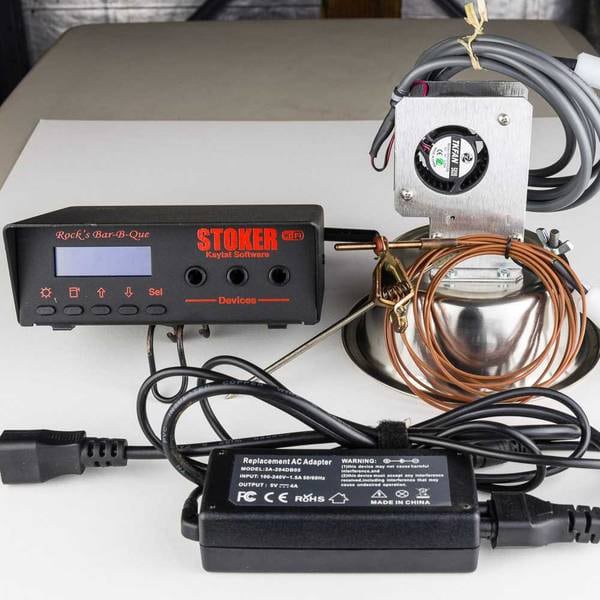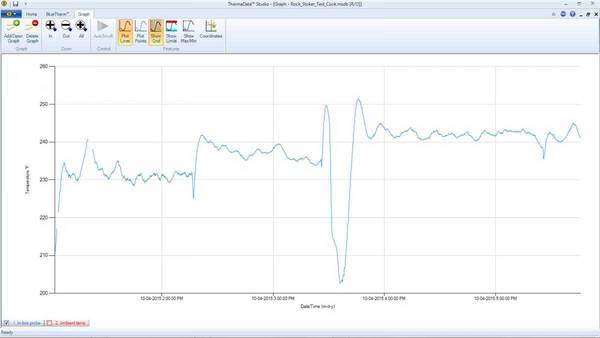YOU ARE HERE >> AmazingRibs » Ratings & Reviews » Ratings Reviews And Buying Guides » Best Thermometers For Food And Cooking » How to Buy the Best In-Food/In-Cooker Thermometer » Rock’s Bar-B-Que Stoker II Review
Rock’s Bar-B-Que Stoker II Review
All of our reviews are done independently by our team of testers and are in no way influenced by advertising or other monetary compensation from manufacturers. Click here to learn more about our unbiased product review process.
Published On: 10/8/2015 Last Modified: 11/4/2025

Note: the picture is of the original Stoker but the two are virtually identical in appearance.
This is a review of an updated product, the Stoker II. The original product, the Stoker, did not perform satisfactorily. The new product corrects the deficiencies found in its predecessor and works very well. I do not yet have the updated user’s manual for the new product, so I cannot talk much about its new features. According to the manufacturer, the significant changes are the direct Wi-Fi connection to the unit and an open-cover ignore mode that prevents an overreaction to the temperature drop caused by opening the cooker lid.
The Rock’s BBQ Stoker II is a complex thermostatic controller with advanced features that allow control of multiple cookers and Wi-Fi access to real-time data via a web browser. The unit, as tested with an adapter designed for the Weber smoker, carries a price tag of $322, a reduction in price from the earlier version. There are three sizes of blowers: 5, 10 and 25 cfm units that take the base unit price from $297 to $400. Adapters for your particular cooker add a small additional cost.
The unit can be configured from the front panel or via a web brower interface. In the latter mode, you can connect wirelessly to the Stoker with your computer or you can connect the unit wirelessly to your router. If you plan to use a router, you need to be familiar with networking concepts such as IP addresses and subnet masks if you want to enable the functionality. You can also set up pairs of blowers and sensors, up to three pair at a time, and configure each separately for target temperature and alarms. There is also a food probe that can be monitored via the web browser, and you can set an alarm to flag that the food has come to the desired temperature. Multiple food probes can be used and alarmed simultaneously. There are also applications available on the manufacturer’s website that will plot temperatures and provide access to other data. I did not test any of the apps.
The idea behind a controller like this is to regulate the temperature inside the cooker by adjusting the airflow. The more air, the hotter it gets. A temperature probe clipped to the grill grate and routed out of the cooker to the controller provides the feedback to the controller needed to make airflow decisions. It’s a lot more complicated than that, but that’s all you really need to know to use this device.
Test Procedure: This product was tested on an 18.5″ Weber Smokey Mountain. The water bucket was about 2/3 full, and there was one slab of ribs in the cooker. The 5 cfm blower was attached to one of the lower vents, and the other bottom vents were closed and the top vent was fully open. The temperature probe was clipped to the side of the top cooking grate. Another temperature probe was mounted on the grate and plugged into a ThermoWorks BlueTherm Duo that was monitored on my computer for temperature recording purposes. The set temperature was 225°F, consistent with smoking practices. Note that the monitor temperature probe was not exactly co-located with the controller probe, so you can expect to see some temperature differences.
The outside air temperature was from 75 to 80°F. Winds were light and variable. Measurements began shortly after the smoker was closed up.
I loaded 2 lbs. of Kingsford Competition Briquets into the cooker, and lit 1 lb. of the same charcoal in a chimney, and poured it on the unlit coals already in the smoker. The charcoal burned for about 2.5 hours before I decided to add more fuel. You’ll see a dip, then a rise in the plotted temperature when I removed the upper part of the cooker to add charcoal. When the ribs were done after about 5 hours, I terminated the test.
The data captured from the ThermoWorks sensor was plotted, and the raw data was exported to Excel so that I could calculate temperature maxima, minima, average and standard deviation. The last value gives a measure of how consistent the temperature remained. If the temperature was dead constant, the standard deviation would be zero. The larger the swings in temperature, the higher the standard deviation would be. Because I disassembled the cooker, causing temperature drops and spikes that were not attributable to the controller, I computed statistics for only the period from 4 p.m. to 5 p.m. when the controller was completely in charge of temperature regulation. Here are the numbers:
Maximum temperature: 240.18°F
Minimum temperature: 243.81°F
Average temperature: 241.93°F
Standard deviation: 0.80°F


As you can see from the graph above (click on the image for a larger version), the temperature swings were about 3.6°F, peak to trough, in the 4-5 p.m. period. This is excellent performance. There are a couple of glitches that need to be explained. At about 2:20, there is a dip and spike caused by my opening the door and jostling the charcoal to promote even burning. The large dip around 3:30 was caused by disassembling the cooker to add more fuel. Note that the temperature recovered smoothly from this interruption. There was another dip around 5:30, again caused by jostling the charcoal. None of these transients reflects negatively on the controller; in fact, they demonstrate that the unit recovers smoothly from perturbations. The Stoker II held the cooker temperature more accurately than any other units I have tested.
The easiest way to use the Stoker II is via the direct Wi-Fi connection so you can set up your probes, target temperature and alarms. Almost anyone with basic computer familiarity should have little or no trouble setting up this configuration. Doing the setup via the front panel is also pretty straightforward. Setting it up to work with your wireless router is a little trickier, but not overly difficult. The ability to have multiple probes is an advantage if you’re cooking different foods at the same time. If you plan to use one cooker and one food probe, you should have no problem getting set up quickly.
This is a fairly high-tech approach to doing barbecue and it will appeal to the gadget crowd without baffling lesser geeks. It’s not cheap, but the construction is more substantial than many of its competitors. Keep it dry and you should get excellent results. The manufacturer has a 30 day return policy and a one year limited warranty.
With its rich feature set and flexibility of setup, and very good performance and build, I’m giving the Stoker II a Gold Medal. This product is a significant upgrade from the original Stoker, and should make its owners happy.
Click the buttons below to search our complete database of reviews:
Product Information:
-
Thermometer Function:Leave in Food, Leave in Cooker, Wireless Remote, Thermostats/Temperature Controllers
-
Item Price :297.00
*Price Subject To Change -
Where to buy (buying from this supplier supports this website):
-
Probe:Food and Cooker included
-
Battery Type:n/a
-
Battery Life:n/a
-
Safe Operating Range:Not specified
-
Display Precision:1°
-
Speed from 32 to 212 Degrees:n/a
-
Numbers Display Size:0.25" (6mm)
-
Water Resistance Rating:Not water resistant
-
C/F Switch:Built in CF switch
-
Backlight:Built in Backlight
-
Color Options:Black
-
Thermometer Sensor:Thermocouple
-
Thermometer Connection:Wifi
-
App:Multiple apps available on mfgr's website
-
Logging:Yes, alone and in apps
-
Included:Display, 2 probes, blower, power supply, quick-start instructions
-
Available Accessories:Adapter to your cooker required in most cases.
-
Alarms:Audible/Visible
Manufacturer:
-
Rock’s Bar-B-Que
-
Bill McGrath, AmazingRibs.com Chief Thermometer Reviewer - Bill McGrath is AmazingRibs.com's Thermometer Maven. He has sophisticated equipment, an electrical engineering degree from Cornell University, and an MBA (almost) from UC Berkeley.
Up Your BBQ IQ By Joining The Pitmaster Club

Sign up for a free trial of the AmazingRibs.com Pitmaster Club and experience everything that the world’s largest membership-based BBQ and grilling community has to offer!

High quality websites are expensive to run. If you help us, we’ll pay you back bigtime with an ad-free experience and a lot of freebies!
Millions come to AmazingRibs.com every month for high quality tested recipes, tips on technique, science, mythbusting, product reviews, and inspiration. But it is expensive to run a website with more than 2,000 pages and we don’t have a big corporate partner to subsidize us.
Our most important source of sustenance is people who join our Pitmaster Club. But please don’t think of it as a donation. Members get MANY great benefits. We block all third-party ads, we give members free ebooks, magazines, interviews, webinars, more recipes, a monthly sweepstakes with prizes worth up to $2,000, discounts on products, and best of all a community of like-minded cooks free of flame wars. Click below to see all the benefits, take a free 30 day trial, and help keep this site alive.
Post comments and questions below
1) Please try the search box at the top of every page before you ask for help.
2) Try to post your question to the appropriate page.
3) Tell us everything we need to know to help such as the type of cooker and thermometer. Dial thermometers are often off by as much as 50°F so if you are not using a good digital thermometer we probably can’t help you with time and temp questions. Please read this article about thermometers.
4) If you are a member of the Pitmaster Club, your comments login is probably different.
5) Posts with links in them may not appear immediately.
Moderators